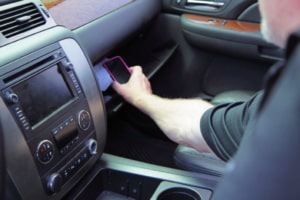Distracted Driving Overview
This year Distracted Driving Awareness month is different than any other year as we “Stay Home, Stay Healthy.” While we want to do everything we can to encourage people to stay off the roads, people are online and looking for information and news besides the latest on the coronavirus. We feel it is an opportunity to share the good news that fatalities from distracted driving are down, and that most people agree that using a hand-held phone while driving is dangerous.
Accordingly we have prepared these sample messages and materials on distracted driving, as well as the news release we distributed on April 1 with the news about a decline in distracted driving related deaths. We’ve also included an updated flyer on the E-DUI law as a refresher and perhaps a helpful tool for parents who can talk to young drivers about distracted driving while they are home.
Key Messages
Washington Distracted Driving Efforts are Working
-
Washington drivers are increasingly off the phone when they are on the road.
-
In 2016, the year before the law passed, 155 people died in crashes involving a distracted driver. In 2019, two years after the new law, 33 fewer distracted driving-related deaths occurred.
-
WTSC conducted a 2019 statewide Traffic Safety Culture Survey and found that most Washingtonians are familiar with the distracted driving laws:
-
Most (74 percent) know that using a hand-held cell phone while driving is illegal
-
Most (68 percent) know that using a cell phone at a traffic light is illegal
-
Most (69 percent) agree that using a hand-held cell phone while driving is dangerous
-
-
WTSC also estimates that Washington’s driver distraction rate was 6.8 percent in 2019, based on the 2019 Statewide Distracted Driving Observational Study.
-
Washington drivers are increasingly off the phone when they are on the road.
Make it a Goal to Have Zero Injuries or Deaths from Distracted Driving in Your Family
-
Continue to set a good example by turning your cell phone off, putting it on “Do Not Disturb” mode, or giving it to a passenger while driving.
-
Encourage others to put their phone away while driving.
-
Talk to your family about and make rules about cell phone use and other distractions.
-
Avoid calling family members or friends when you know they are driving.
-
Emphasize cell phone use is also illegal when stopped at traffic signals and stop signs.
###
News Release
Distracted Driving Fatalities Down in Washington
In 2016, the year before the law passed, 155 people died in crashes involving a distracted driver. In 2019, two years after the new law, 33 fewer distracted driving-related deaths occurred.
“Washington’s Distracted Driving law is working,” said Erika Mascorro, WTSC Program Manager, “The data shows that Washington culture around distracted driving is changing. With Washingtonians at home observing the governor’s Stay Home, Stay Healthy order, now is a good opportunity to review with the importance of being an attentive driver, so our families will be safer when we all return to the roads.
”WTSC conducted a 2019 statewide Traffic Safety Culture Survey1and found that most Washingtonians are familiar with the distracted diving laws:
- Most (74 percent) know that using a hand-held cell phone while driving is illegal
- Most (68 percent) know that using a cell phone at a traffic light is illegal
- Most (69 percent) agree that using a hand-held cell phone while driving is dangerous
WTSC also estimates that Washington’s driver distraction rate was 6.8 percent in 2019, based on the 2019 Statewide Distracted Driving Observational Study. Cell phones remain the greatest source of distraction, with two of every three distracted drivers in Washington observed either using or talking on a hand-held phone. The observational study also found slightly more people distracted on city streets than county roads or state routes.
As we watch the culture change around phone use while driving, now is a good time to encourage drivers who have figured out how to keep their cell phones from distracting them to share their skills,” said Mascorro. The traffic safety culture survey showed that most Washingtonians (83 percent) reported encouraging a driver to put the phone down when they find themselves as a passenger with a distracted driver.
“There are steps everyone can take to encourage attentive driving,” Mascorro said. These steps include:
- Continue to set a good example by turning your cell phone off, putting it on “Do Not Disturb” mode,or giving it to a passenger while driving•Encourage others to put their phone away while driving
- Talk to your family about and make rules about cell phone use and other distractions
- Avoid calling family members or friends when you know they are driving
- Emphasize cell phone use is also illegal when stopped at traffic signals and stop signs.Mascorro said, “We’ve made progress in Washington, but we can each do more. Aim to have zero distracted drivers in your family.”
Distracted Driving Law Flyer
Obey the Distracted Driving Law It’s Saving Lives!
Make your goal zero fatalities or injuries in your family from distracted driving.
- Fatalities from distracted driving have declined in Washington since the distracted driving law went into effect in 2017.
- Most Washingtonians agree that using a hand-held phone while driving is dangerous.
Know and follow the law – zero fatalities or injuries in your family from distracted driving: No hand‐held cell phone use
- Drivers may not use hand-held cell phones while they are driving, stopped in traffic, or at a stop light. This includes tablets, laptops, games, or other hand-held electronic devices.
- Drivers may not watch video while they drive.
- This does not apply if a driver is contacting emergency services.
- Drivers can use hand-held devices when they are parked or out-of -the-flow of traffic.
Hands‐free use is allowed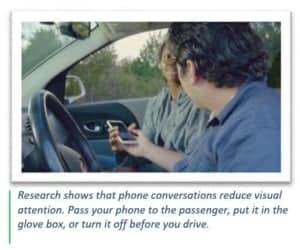
- Hands-free use, such as through Bluetooth, is allowed as is a single touch to start a function. Start GPS or music before you drive.
Dangerously distracted
- “Dangerously distracted” means a person who engages in any activity not related to the actual operation of a motor vehicle in a manner that interferes with the safe operation of such motor vehicle on any highway. If the driver does commit a traffic offense because the driver is dangerously distracted, then they are subject to an additional $99 fine.
Not included
- Some things are not included in the law. Transit and emergency vehicle drivers are exempt. Drivers of commercial vehicles must follow federal laws.
- Two-way radio, citizens band radio, or amateur radio equipment are not included in the law.
Costs
- The first ticket will cost at least $136. Get a ticket again within five years, and those tickets cost at least $234. All violations will be available to insurance companies
Sample Social Media Messages & Graphics
The following are sample graphics and related content that we encourage you to use on your organization’s social media. Feel free to adapt for use on your website or customized emails too. Please click on the link below each image to download for posting on Facebook, Twitter, and/or Instagram.
Most people don’t drive distracted. For once it’s cool to be part of the crowd. #DistractedDriving #Focus
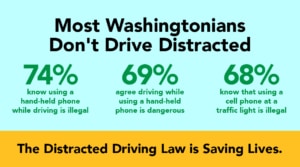
Ya no ay excusas. Llevar el teléfono celular en las manos mientras maneja es peligroso y en contra la ley. Guarde su celular si va a manejar.
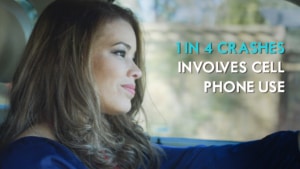
Family members would rather know you are safe than what’s for dinner. Don’t text and drive. It’s the law. #DistractedDriving #Focus
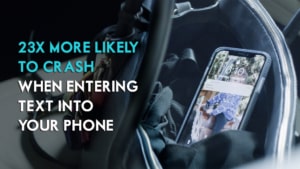
A lot can happen in the time it takes you to re-focus after using your phone. Most people don’t risk it. Put it away. #DistractedDriving #Focus
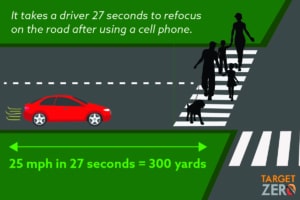
Most Washingtontonians are familiar with the distracted driving laws. For example, 74% know that using a hand-held cell phone while driving is illegal. They put it away when they drive. #DistractedDriving #Focus

